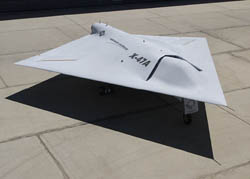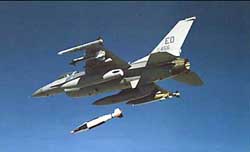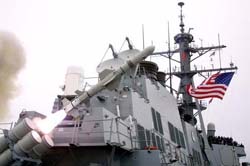Daily News
by Gail Helmer
[ Send Us News | Archives ]
New Screens: Team Factor
7FX has released 20 new screenshots from the upcoming first-person shooter, Team Factor. The game will feature three different teams: red, which represents the Russian Spetznaz; blue, a combination of US Army Rangers and German Fallschirmjaegers; and black, which represents the rest of the world. Each team has four basic character types with unique abilities. The game will include more than 40 types of realistic weapons, including pistols, rifles, shotguns, grenades, and machine guns. Release Date: May 25, 2002. Just between you and me these are strange looking screenshots.
Iron Storm Movie
There is a new trailer of Iron Storm, the sniper-heavy first- and third-person shooter being developed at 4X Studio. This movie sports a minute and a half of cinematic and gameplay footage from the game, which is set in an alternate history World War I that's still raging in the 1960's. Download
X-Plane Demo/Upgrade v6.13
Another update for X-Plane is now available, taking the comprehensive flight simulation by Laminar Research to version 6.13. This release brings performance improvements, a bunch of new features and refinements, bug fixes and more, and as before you can use a patch from the previous v6.12, or a full upgrade from any older version (which also serves as a time-limited demo). Details -- Download
Military News
Pegasus Team Completes Engine Test Milestone
Northrop Grumman Corporation's X-47A Pegasus team has completed another milestone on the road to first flight with the successful autonomous start and shutdown of the experimental unmanned aircraft's engine.
With a click of a computer mouse, the air vehicle operator executed a command from inside the test control center at the Northrop Grumman Integrated Systems facility here, which allowed the X-47A to autonomously sequence through the engine start series and come to idle. Test team engineers then confirmed subsystems and engine performance. Once satisfied that all systems were working as planned, the operator initiated an autonomous shutdown of the Pratt & Whitney JT15D engine. This sequence was repeated several times. According to Dave Mazur, Pegasus program manager, the X-47A performed flawlessly during the April 18 test.

Pegasus was built with company funds to demonstrate aerodynamic qualities suitable for autonomous operation from an aircraft carrier. The results will be used in Northrop Grumman's naval Unmanned Combat Air Vehicle (UCAV-N) program for the Defense Advanced Research Projects Agency (DARPA) and the U.S. Navy. First flight of the X-47A is expected later this year.
The goal of the joint DARPA/Navy UCAV-N project is to demonstrate the technical feasibility for an unmanned system to effectively and affordably conduct sea-based surveillance, strike and suppression of enemy air defenses missions within the emerging global command and control architecture.
Successful Flight Tests of 500-pound JDAM
The U.S. Air Force has successfully flight tested the Boeing MK-82 (500-pound) Joint Direct Attack Munition (JDAM) at Eglin Air Force Base, Fla. A U.S. Air Force F-16 launched the weapon from 20,000 feet and 6 miles from its target. The JDAM flew its planned flight path to a direct hit on the target. The U.S. Air Force awarded $45 million to Boeing for engineering, manufacturing and development (EMD) of the 500-pound JDAM in September 2000.
"The EMD flight test program is being conducted on the F-16 with follow-on integration on the U.S. Air Force's B-2 and the U.S. Navy's F/A-18 aircraft," said Kim Michel, Boeing JDAM program manager. "This smaller version of JDAM improves mission capability by allowing more JDAMs to be loaded on an aircraft and reduces damage around the intended target due to the smaller warhead."

The flight test program began in December 2000 with captive-carry flights and fit checks from a number of different aircraft. Controlled (guided) launches and separation flight tests have been conducted at Eglin Air Force Base since the beginning of the year. Separation flights began in April at Patuxent River, Md., from a U.S. Navy F/A-18C/D aircraft.
"The MK-82 JDAM EMD program is very healthy; exceeding requirements, on schedule and within cost," said David Martin, Boeing MK-82 JDAM program manager.
Originally designed for 2,000-pound (MK-84 and BLU-109) warheads, JDAM kits have been developed for 1,000-pound (MK-83 and BLU-110) warheads. The MK-82 guidance kit is common to all JDAM variants. The same mission computer, navigation unit and satellite receiver are used in all JDAM kits.
The MK-82 JDAM and the bomb rack assemblies for the B-2 will be available in 2004. Boeing, teamed with European weapons manufacturer MBDA, is offering the MK-82 JDAM guidance kit to satisfy the United Kingdom Precision Guided Bomb Program requirement. A decision is expected in December 2002.
Boeing Delivers First Harpoon Block II Kits to Denmark
The Danish Naval Materiel Command has taken delivery of the first Harpoon Block II missiles following installation of upgrade kits, marking the first international sale of the upgraded missile.
The Harpoon Block II kit provides a new Guidance Control Unit flight computer, a new guidance section shell and a Global Positioning System (GPS) antenna. When installed, the Harpoon missile has a more accurate navigation system and can be used for coastal target suppression. The kits will be installed by the Royal Netherlands Navy for the Royal Danish Navy at their joint missile maintenance facility in Den Helder, Netherlands.
The Block II missile incorporates key guidance technologies from two other Boeing weapons programs - the low-cost, inertial measuring unit from the Joint Direct Attack Munition; and the software, mission computer, integrated GPS/Inertial Navigation System, and GPS antenna and receiver from the Standoff Land Attack Missile Expanded-Response. These technologies expand Harpoon's capability to attack coastal, in-harbor and land targets such as shore defense sites, SAM sites, exposed aircraft, port/industrial facilities and ships in port.

The U.S. Navy completed flight-testing of the Harpoon Block II in November 2001. During flight-testing, the Harpoon Block II demonstrated precision attacks against open water and close-to-land ships as well as land targets.
Denmark, an existing Harpoon customer, was the first country to sign a $10 million contract for 50 upgrade kits in 1997. This modification upgrades about half of the Royal Danish Navy inventory, providing greater accuracy against ship targets and providing land strike capability for the first time.
[ Send Us News | Archives ]
by Gail Helmer
Monday April 29, 2002
- New Screens: Team Factor
- Iron Storm Movie
- X-Plane Demo/Upgrade v6.13
- Pegasus Team Completes Engine Test Milestone
- Successful Flight Tests of 500-pound JDAM
- Boeing Delivers First Harpoon Block II Kits to Denmark
New Screens: Team Factor
7FX has released 20 new screenshots from the upcoming first-person shooter, Team Factor. The game will feature three different teams: red, which represents the Russian Spetznaz; blue, a combination of US Army Rangers and German Fallschirmjaegers; and black, which represents the rest of the world. Each team has four basic character types with unique abilities. The game will include more than 40 types of realistic weapons, including pistols, rifles, shotguns, grenades, and machine guns. Release Date: May 25, 2002. Just between you and me these are strange looking screenshots.
Iron Storm Movie
There is a new trailer of Iron Storm, the sniper-heavy first- and third-person shooter being developed at 4X Studio. This movie sports a minute and a half of cinematic and gameplay footage from the game, which is set in an alternate history World War I that's still raging in the 1960's. Download
X-Plane Demo/Upgrade v6.13
Another update for X-Plane is now available, taking the comprehensive flight simulation by Laminar Research to version 6.13. This release brings performance improvements, a bunch of new features and refinements, bug fixes and more, and as before you can use a patch from the previous v6.12, or a full upgrade from any older version (which also serves as a time-limited demo). Details -- Download
Military News
Pegasus Team Completes Engine Test Milestone
Northrop Grumman Corporation's X-47A Pegasus team has completed another milestone on the road to first flight with the successful autonomous start and shutdown of the experimental unmanned aircraft's engine.
With a click of a computer mouse, the air vehicle operator executed a command from inside the test control center at the Northrop Grumman Integrated Systems facility here, which allowed the X-47A to autonomously sequence through the engine start series and come to idle. Test team engineers then confirmed subsystems and engine performance. Once satisfied that all systems were working as planned, the operator initiated an autonomous shutdown of the Pratt & Whitney JT15D engine. This sequence was repeated several times. According to Dave Mazur, Pegasus program manager, the X-47A performed flawlessly during the April 18 test.

Pegasus was built with company funds to demonstrate aerodynamic qualities suitable for autonomous operation from an aircraft carrier. The results will be used in Northrop Grumman's naval Unmanned Combat Air Vehicle (UCAV-N) program for the Defense Advanced Research Projects Agency (DARPA) and the U.S. Navy. First flight of the X-47A is expected later this year.
The goal of the joint DARPA/Navy UCAV-N project is to demonstrate the technical feasibility for an unmanned system to effectively and affordably conduct sea-based surveillance, strike and suppression of enemy air defenses missions within the emerging global command and control architecture.
Successful Flight Tests of 500-pound JDAM
The U.S. Air Force has successfully flight tested the Boeing MK-82 (500-pound) Joint Direct Attack Munition (JDAM) at Eglin Air Force Base, Fla. A U.S. Air Force F-16 launched the weapon from 20,000 feet and 6 miles from its target. The JDAM flew its planned flight path to a direct hit on the target. The U.S. Air Force awarded $45 million to Boeing for engineering, manufacturing and development (EMD) of the 500-pound JDAM in September 2000.
"The EMD flight test program is being conducted on the F-16 with follow-on integration on the U.S. Air Force's B-2 and the U.S. Navy's F/A-18 aircraft," said Kim Michel, Boeing JDAM program manager. "This smaller version of JDAM improves mission capability by allowing more JDAMs to be loaded on an aircraft and reduces damage around the intended target due to the smaller warhead."

The flight test program began in December 2000 with captive-carry flights and fit checks from a number of different aircraft. Controlled (guided) launches and separation flight tests have been conducted at Eglin Air Force Base since the beginning of the year. Separation flights began in April at Patuxent River, Md., from a U.S. Navy F/A-18C/D aircraft.
"The MK-82 JDAM EMD program is very healthy; exceeding requirements, on schedule and within cost," said David Martin, Boeing MK-82 JDAM program manager.
Originally designed for 2,000-pound (MK-84 and BLU-109) warheads, JDAM kits have been developed for 1,000-pound (MK-83 and BLU-110) warheads. The MK-82 guidance kit is common to all JDAM variants. The same mission computer, navigation unit and satellite receiver are used in all JDAM kits.
The MK-82 JDAM and the bomb rack assemblies for the B-2 will be available in 2004. Boeing, teamed with European weapons manufacturer MBDA, is offering the MK-82 JDAM guidance kit to satisfy the United Kingdom Precision Guided Bomb Program requirement. A decision is expected in December 2002.
Boeing Delivers First Harpoon Block II Kits to Denmark
The Danish Naval Materiel Command has taken delivery of the first Harpoon Block II missiles following installation of upgrade kits, marking the first international sale of the upgraded missile.
The Harpoon Block II kit provides a new Guidance Control Unit flight computer, a new guidance section shell and a Global Positioning System (GPS) antenna. When installed, the Harpoon missile has a more accurate navigation system and can be used for coastal target suppression. The kits will be installed by the Royal Netherlands Navy for the Royal Danish Navy at their joint missile maintenance facility in Den Helder, Netherlands.
The Block II missile incorporates key guidance technologies from two other Boeing weapons programs - the low-cost, inertial measuring unit from the Joint Direct Attack Munition; and the software, mission computer, integrated GPS/Inertial Navigation System, and GPS antenna and receiver from the Standoff Land Attack Missile Expanded-Response. These technologies expand Harpoon's capability to attack coastal, in-harbor and land targets such as shore defense sites, SAM sites, exposed aircraft, port/industrial facilities and ships in port.

The U.S. Navy completed flight-testing of the Harpoon Block II in November 2001. During flight-testing, the Harpoon Block II demonstrated precision attacks against open water and close-to-land ships as well as land targets.
Denmark, an existing Harpoon customer, was the first country to sign a $10 million contract for 50 upgrade kits in 1997. This modification upgrades about half of the Royal Danish Navy inventory, providing greater accuracy against ship targets and providing land strike capability for the first time.
